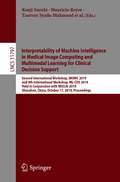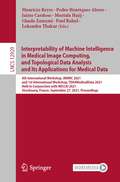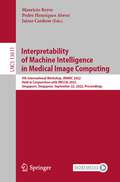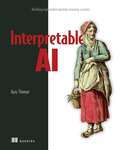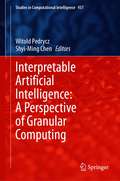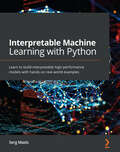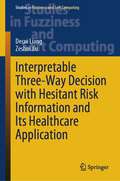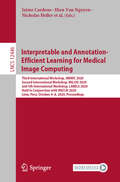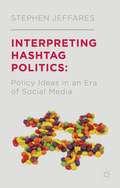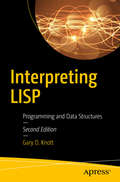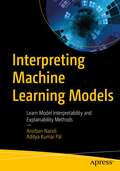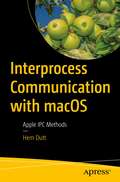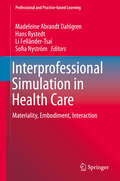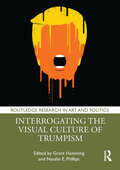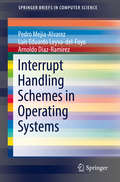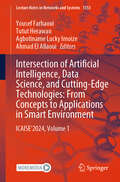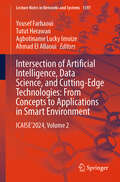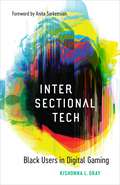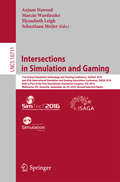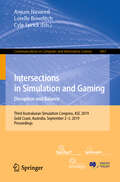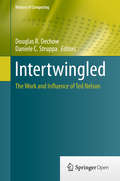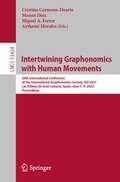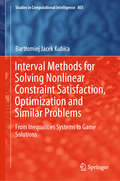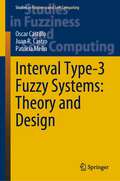- Table View
- List View
Interpretability of Machine Intelligence in Medical Image Computing and Multimodal Learning for Clinical Decision Support: Second International Workshop, iMIMIC 2019, and 9th International Workshop, ML-CDS 2019, Held in Conjunction with MICCAI 2019, Shenzhen, China, October 17, 2019, Proceedings (Lecture Notes in Computer Science #11797)
by Ben Glocker Kenji Suzuki Mauricio Reyes Tanveer Syeda-Mahmood Hayit Greenspan Anant Madabhushi Roland Wiest Eth Zurich Yaniv GurThis book constitutes the refereed joint proceedings of the Second International Workshop on Interpretability of Machine Intelligence in Medical Image Computing, iMIMIC 2019, and the 9th International Workshop on Multimodal Learning for Clinical Decision Support, ML-CDS 2019, held in conjunction with the 22nd International Conference on Medical Imaging and Computer-Assisted Intervention, MICCAI 2019, in Shenzhen, China, in October 2019. The 7 full papers presented at iMIMIC 2019 and the 3 full papers presented at ML-CDS 2019 were carefully reviewed and selected from 10 submissions to iMIMIC and numerous submissions to ML-CDS. The iMIMIC papers focus on introducing the challenges and opportunities related to the topic of interpretability of machine learning systems in the context of medical imaging and computer assisted intervention. The ML-CDS papers discuss machine learning on multimodal data sets for clinical decision support and treatment planning.
Interpretability of Machine Intelligence in Medical Image Computing, and Topological Data Analysis and Its Applications for Medical Data: 4th International Workshop, iMIMIC 2021, and 1st International Workshop, TDA4MedicalData 2021, Held in Conjunction with MICCAI 2021, Strasbourg, France, September 27, 2021, Proceedings (Lecture Notes in Computer Science #12929)
by Jaime Cardoso Mauricio Reyes Pedro Henriques Abreu Mustafa Hajij Ghada Zamzmi Paul Rahul Lokendra ThakurThis book constitutes the refereed joint proceedings of the 4th International Workshop on Interpretability of Machine Intelligence in Medical Image Computing, iMIMIC 2020, and the First International Workshop on Topological Data Analysis and Its Applications for Medical Data, TDA4MedicalData 2021, held on September 27, 2021, in conjunction with the 24th International Conference on Medical Imaging and Computer-Assisted Intervention, MICCAI 2021.The 7 full papers presented at iMIMIC 2021 and 5 full papers held at TDA4MedicalData 2021 were carefully reviewed and selected from 12 submissions each. The iMIMIC papers focus on introducing the challenges and opportunities related to the topic of interpretability of machine learning systems in the context of medical imaging and computer assisted intervention. TDA4MedicalData is focusing on using TDA techniques to enhance the performance, generalizability, efficiency, and explainability of the current methods applied to medical data.
Interpretability of Machine Intelligence in Medical Image Computing: 5th International Workshop, iMIMIC 2022, Held in Conjunction with MICCAI 2022, Singapore, Singapore, September 22, 2022, Proceedings (Lecture Notes in Computer Science #13611)
by Jaime Cardoso Mauricio Reyes Pedro Henriques AbreuThis book constitutes the refereed joint proceedings of the 5th International Workshop on Interpretability of Machine Intelligence in Medical Image Computing, iMIMIC 2022, held in September 2022, in conjunction with the 25th International Conference on Medical Imaging and Computer-Assisted Intervention, MICCAI 2022.The 10 full papers presented at iMIMIC 2022 were carefully reviewed and selected from 24 submissions each. The iMIMIC papers focus on introducing the challenges and opportunities related to the topic of interpretability of machine learning systems in the context of medical imaging and computer assisted intervention.
Interpretable AI: Building explainable machine learning systems
by Ajay ThampiAI doesn&’t have to be a black box. These practical techniques help shine a light on your model&’s mysterious inner workings. Make your AI more transparent, and you&’ll improve trust in your results, combat data leakage and bias, and ensure compliance with legal requirements.In Interpretable AI, you will learn: Why AI models are hard to interpret Interpreting white box models such as linear regression, decision trees, and generalized additive models Partial dependence plots, LIME, SHAP and Anchors, and other techniques such as saliency mapping, network dissection, and representational learning What fairness is and how to mitigate bias in AI systems Implement robust AI systems that are GDPR-compliant Interpretable AI opens up the black box of your AI models. It teaches cutting-edge techniques and best practices that can make even complex AI systems interpretable. Each method is easy to implement with just Python and open source libraries. You&’ll learn to identify when you can utilize models that are inherently transparent, and how to mitigate opacity when your problem demands the power of a hard-to-interpret deep learning model. About the technology It&’s often difficult to explain how deep learning models work, even for the data scientists who create them. Improving transparency and interpretability in machine learning models minimizes errors, reduces unintended bias, and increases trust in the outcomes. This unique book contains techniques for looking inside &“black box&” models, designing accountable algorithms, and understanding the factors that cause skewed results. About the book Interpretable AI teaches you to identify the patterns your model has learned and why it produces its results. As you read, you&’ll pick up algorithm-specific approaches, like interpreting regression and generalized additive models, along with tips to improve performance during training. You&’ll also explore methods for interpreting complex deep learning models where some processes are not easily observable. AI transparency is a fast-moving field, and this book simplifies cutting-edge research into practical methods you can implement with Python. What's inside Techniques for interpreting AI models Counteract errors from bias, data leakage, and concept drift Measuring fairness and mitigating bias Building GDPR-compliant AI systems About the reader For data scientists and engineers familiar with Python and machine learning. About the author Ajay Thampi is a machine learning engineer focused on responsible AI and fairness. Table of Contents PART 1 INTERPRETABILITY BASICS 1 Introduction 2 White-box models PART 2 INTERPRETING MODEL PROCESSING 3 Model-agnostic methods: Global interpretability 4 Model-agnostic methods: Local interpretability 5 Saliency mapping PART 3 INTERPRETING MODEL REPRESENTATIONS 6 Understanding layers and units 7 Understanding semantic similarity PART 4 FAIRNESS AND BIAS 8 Fairness and mitigating bias 9 Path to explainable AI
Interpretable Artificial Intelligence: A Perspective of Granular Computing (Studies in Computational Intelligence #937)
by Witold Pedrycz Shyi-Ming ChenThis book offers a comprehensive treatise on the recent pursuits of Artificial Intelligence (AI) – Explainable Artificial Intelligence (XAI) by casting the crucial features of interpretability and explainability in the original framework of Granular Computing. The innovative perspective established with the aid of information granules provides a high level of human centricity and transparency central to the development of AI constructs. The chapters reflect the breadth of the area and cover recent developments in the methodology, advanced algorithms and applications of XAI to visual analytics, knowledge representation, learning and interpretation. The book appeals to a broad audience including researchers and practitioners interested in gaining exposure to the rapidly growing body of knowledge in AI and intelligent systems.
Interpretable Machine Learning with Python: Learn to build interpretable high-performance models with hands-on real-world examples
by Serg MasisUnderstand the key aspects and challenges of machine learning interpretability, learn how to overcome them with interpretation methods, and leverage them to build fairer, safer, and more reliable modelsKey FeaturesLearn how to extract easy-to-understand insights from any machine learning modelBecome well-versed with interpretability techniques to build fairer, safer, and more reliable modelsMitigate risks in AI systems before they have broader implications by learning how to debug black-box modelsBook DescriptionDo you want to understand your models and mitigate risks associated with poor predictions using machine learning (ML) interpretation? Interpretable Machine Learning with Python can help you work effectively with ML models. The first section of the book is a beginner's guide to interpretability, covering its relevance in business and exploring its key aspects and challenges. You'll focus on how white-box models work, compare them to black-box and glass-box models, and examine their trade-off. The second section will get you up to speed with a vast array of interpretation methods, also known as Explainable AI (XAI) methods, and how to apply them to different use cases, be it for classification or regression, for tabular, time-series, image or text. In addition to the step-by-step code, the book also helps the reader to interpret model outcomes using examples. In the third section, you'll get hands-on with tuning models and training data for interpretability by reducing complexity, mitigating bias, placing guardrails, and enhancing reliability. The methods you'll explore here range from state-of-the-art feature selection and dataset debiasing methods to monotonic constraints and adversarial retraining. By the end of this book, you'll be able to understand ML models better and enhance them through interpretability tuning.What you will learnRecognize the importance of interpretability in businessStudy models that are intrinsically interpretable such as linear models, decision trees, and Naive BayesBecome well-versed in interpreting models with model-agnostic methodsVisualize how an image classifier works and what it learnsUnderstand how to mitigate the influence of bias in datasetsDiscover how to make models more reliable with adversarial robustnessUse monotonic constraints to make fairer and safer modelsWho this book is forThis book is for data scientists, machine learning developers, and data stewards who have an increasingly critical responsibility to explain how the AI systems they develop work, their impact on decision making, and how they identify and manage bias. Working knowledge of machine learning and the Python programming language is expected.
Interpretable Three-Way Decision with Hesitant Risk Information and Its Healthcare Application (Studies in Fuzziness and Soft Computing #431)
by Zeshui Xu Decui LiangAs a new interpretable model, three-way decision has also received academic attention in machine learning. With respect to different hesitant fuzzy information, this book deeply discusses the deduction process of decision rules of three-way decision and generates interpretable knowledge with the risk semantics. It further explores the applications of three-way decision to support healthcare management. This book is used as a reference for engineers, technicians, and researchers who are working in the fields of management science, operation management, computer science, information management, fuzzy mathematics, business intelligence, and other fields. It also serves as a textbook for postgraduate and senior undergraduate students of the relevant professional institutions of higher learning.
Interpretable and Annotation-Efficient Learning for Medical Image Computing: Third International Workshop, iMIMIC 2020, Second International Workshop, MIL3iD 2020, and 5th International Workshop, LABELS 2020, Held in Conjunction with MICCAI 2020, Lima, Peru, October 4–8, 2020, Proceedings (Lecture Notes in Computer Science #12446)
by Jaime Cardoso Emanuele Trucco Diana Mateus Veronika Cheplygina Pedro Henriques Abreu Raphael Sznitman Nicholas Heller Steve Jiang Vishal Patel Badri Roysam Kevin Zhou Khoa Luu Ngan Le Hien Van Nguyen Ivana Isgum Wilson Silva Ricardo Cruz Jose Pereira Amorim Samaneh AbbasiThis book constitutes the refereed joint proceedings of the Third International Workshop on Interpretability of Machine Intelligence in Medical Image Computing, iMIMIC 2020, the Second International Workshop on Medical Image Learning with Less Labels and Imperfect Data, MIL3ID 2020, and the 5th International Workshop on Large-scale Annotation of Biomedical data and Expert Label Synthesis, LABELS 2020, held in conjunction with the 23rd International Conference on Medical Imaging and Computer-Assisted Intervention, MICCAI 2020, in Lima, Peru, in October 2020. The 8 full papers presented at iMIMIC 2020, 11 full papers to MIL3ID 2020, and the 10 full papers presented at LABELS 2020 were carefully reviewed and selected from 16 submissions to iMIMIC, 28 to MIL3ID, and 12 submissions to LABELS. The iMIMIC papers focus on introducing the challenges and opportunities related to the topic of interpretability of machine learning systems in the context of medical imaging and computer assisted intervention. MIL3ID deals with best practices in medical image learning with label scarcity and data imperfection. The LABELS papers present a variety of approaches for dealing with a limited number of labels, from semi-supervised learning to crowdsourcing.
Interpreting Hashtag Politics
by Stephen JeffaresWhy do policy actors create branded policy ideas like Big Society and does launching them on Twitter extend or curtail their life? This book reveals how policy analysis can adapt in an increasingly mediatised to offer interpretive insights into the life and death of policy ideas in an era of hashtag politics.
Interpreting LISP
by Gary D. KnottLearn Lisp programming in a data structures context, including tables, functions, forms, expressions, typed-pointers, I/O, garbage collection and some applications. This short primer contains a careful description of the data structures manipulated by Lisp functions. These data structures and others, notably hash tables, are also used in constructing a Lisp interpreter. Interpreting Lisp will be of special interest to those learning and using programming languages and computer architecture as well as data structures. This book will be useful to autodidacts, professional programmers, and computer enthusiasts in a wide variety of fields. What You'll Learn Use the atom table and the number table in Lisp Master expressions, typed pointers, arguments and results in typed pointers, and more Write lambda expressions in Lisp Bind actual values to formal arguments Develop games in Lisp Who This Book Is For Experienced programmers new to Lisp.
Interpreting Machine Learning Models: Learn Model Interpretability and Explainability Methods
by Anirban Nandi Aditya Kumar PalUnderstand model interpretability methods and apply the most suitable one for your machine learning project. This book details the concepts of machine learning interpretability along with different types of explainability algorithms. You’ll begin by reviewing the theoretical aspects of machine learning interpretability. In the first few sections you’ll learn what interpretability is, what the common properties of interpretability methods are, the general taxonomy for classifying methods into different sections, and how the methods should be assessed in terms of human factors and technical requirements. Using a holistic approach featuring detailed examples, this book also includes quotes from actual business leaders and technical experts to showcase how real life users perceive interpretability and its related methods, goals, stages, and properties. Progressing through the book, you’ll dive deep into the technical details of the interpretability domain. Starting off with the general frameworks of different types of methods, you’ll use a data set to see how each method generates output with actual code and implementations. These methods are divided into different types based on their explanation frameworks, with some common categories listed as feature importance based methods, rule based methods, saliency maps methods, counterfactuals, and concept attribution. The book concludes by showing how data effects interpretability and some of the pitfalls prevalent when using explainability methods. What You’ll LearnUnderstand machine learning model interpretability Explore the different properties and selection requirements of various interpretability methodsReview the different types of interpretability methods used in real life by technical experts Interpret the output of various methods and understand the underlying problems Who This Book Is For Machine learning practitioners, data scientists and statisticians interested in making machine learning models interpretable and explainable; academic students pursuing courses of data science and business analytics.
Interpreting the CMMI (R): A Process Improvement Approach, Second Edition
by Margaret K. Kulpa Kent A. JohnsonTaking a broad approach that speaks to experienced and inexperienced process improvement practitioners, CMMI experts and CMMI novices, this second edition thoroughly examines the latest version of the CMMI. Divided into six sections, the text first clarifies the concept of process improvement, makes the case for how and why to employ CMMI, and outlines its structure. It then provides an overview of the process areas, supported by real-world display tables, templates, and charts designed to aid organizations in their improvement efforts. Subsequent sections address measurement issues including basic metrics, statistical process control, and high maturity concerns, as well as SCAMPISM appraisal types.
Interprocess Communication with macOS: Apple IPC Methods
by Hem DuttBuild highly modular software in macOS that interacts deeply and intuitively with other programs. This book explores all techniques available for Inter-process communications (IPC) from high level macOS layers to deep kernel options while applying theoretical concepts into practical implementations on real world scenarios.You'll see how IPC techniques are used for exchanging data and messages among multiple threads in one or more processes, which may be running on one or more computers connected by a network or running locally. IPC methods can be divided into methods for message passing, synchronization, shared memory, and remote procedure calls (RPC). A poorly conceived IPC can even expose an entire network to over-the-network attacks. Despite the risks, processes and applications absolutely need to communicate with each other across your system and the network. You'll see how these communications facilitate information sharing, computational speedup, modularity, convenience, and privilege separation. In macOS, a program has a number of ways to communicate with other programs. These mechanisms for IPC often exist in different layers of the system. You'll examine how each has its own specific purposes, limitations, and intended scenarios. Some are more suitable than others for code written at a certain level of the system. For example, a kernel extension would not make use of Apple events. Additionally, the book reveals that different users have different rights when it comes to accessing files, changing system wide settings, and so on, depending on whether they are admin users or ordinary users. Running code with root or administrative privileges can intensify the dangers posed by security vulnerabilities. You'll learn that to elevate privileges safely, it is mandatory for the application to perform the task through a secure Helper process.What You'll LearnExpand the capabilities of your programs by sharing data within multiple applicationsUnderstand and dig deep into the world of Helper tools to create apps that need user privilege elevationEnhance the modularity of a system by allowing your applications to interact and share data with a websiteWho This Book Is ForSoftware engineers and architects designing and developing secure applications for macOS and iOS who have hands-on knowledge of Swift with XCode.
Interprofessional Simulation in Health Care: Materiality, Embodiment, Interaction (Professional and Practice-based Learning #26)
by Madeleine Abrandt Dahlgren Hans Rystedt Li Felländer-Tsai Sofia NyströmThis book describes and discusses a practice-oriented approach to understanding and researching interprofessional simulation-based education and simulation. It provides empirical findings from research on this topic and is informed by practice-oriented perspectives. It identifies critical features of the simulation practice and discusses how these can be used in reforming simulation pedagogy. The book is divided into three sections. Section 1 sets the scene for understanding the practices of interprofessional simulation-based education and simulation. It provides a theoretical and methodological framework for the conceptualisation of practices and for the empirical studies on which the book is based. Section 2 revisits the dimensions of the simulation process/exercise, i.e. the briefing, simulation, and debriefing, and provides empirical analyses of how the practice of simulation unfolds. Based on these analyses, section 3 identifies and discusses how pedagogies for simulation can be reformed to meet the demands of future healthcare and research.
Interrogating the Visual Culture of Trumpism (Routledge Research in Art and Politics)
by Grant Hamming Natalie E. PhillipsBringing together scholars from art history, visual studies, and related disciplines, this edited volume asks why Trumpism looks the way it does and what that look means for American—and global—society.Grouped into six categories, the essays in this volume tackle some of the most perplexing—and urgent—aspects of the Trumpist visual project. Two of the most striking aspects of that project are its use of novel commodity forms, including the iconic red baseball caps, as well as its embrace of social media. Trump’s outlandish persona and striking physicality have lent themselves to caricature both from his critics and, perhaps more surprisingly, his supporters. That physicality—as well as his movement’s hearkening back to a (mostly imagined) era of mid-twentieth-century prosperity—has also brought gender and the body into sharp focus. Perhaps second only to the aforementioned red hat is Trumpism’s vigorous use of interventions into public space, including traditional campaign signs as well as flags and other ad hoc visual and architectural materials. Finally, there were the events of January 6, 2021, when many of Trumpism’s most outré visual and cultural preoccupations exploded from the shadows onto television screens across the country. Taken as a whole, the essays in this book examine Trumpist visuality from the seemingly trivial to the starkly horrifying, as well as offering a measured sense of the various resistances and responses that have characterized artistic responses to Trump from the beginning of his prominence.The book will be of interest to scholars working in art history, visual culture, American studies, and cultural and media studies.
Interrupt Handling Schemes in Operating Systems (SpringerBriefs in Computer Science)
by Pedro Mejia-Alvarez Luis Eduardo Leyva-del-Foyo Arnaldo Diaz-RamirezIn this book, the interrupt handling models used by several operating systems are introduced and compared. We begin with an analysis of the classical interrupt management model used by Unix, followed by the schemes used by modern networked environments. We highlight the key challenges of each of these models and how these have been solved by modern operating systems and the research community. Then we analyze the architectures used for general purpose and embedded real-time operating systems.
Intersection of Artificial Intelligence, Data Science, and Cutting-Edge Technologies: ICAISE’2024, Volume 1 (Lecture Notes in Networks and Systems #1353)
by Tutut Herawan Yousef Farhaoui Agbotiname Lucky Imoize Ahmad El AllaouiThis book explores the integration of AI, data science, and emerging technologies to create innovative, practical solutions for smart environments. This book offers a comprehensive framework that combines theoretical concepts with real-world applications, focusing on how these technologies intersect to transform various domains such as healthcare, urban planning, and sustainable development. The book's novel approach emphasizes interdisciplinary methods and problem-solving in dynamic, data-driven environments, with case studies illustrating practical impacts and advancements in smart city infrastructure, IoT, and predictive analytics. It is designed for researchers, practitioners, and advanced students interested in AI and data science applications within smart systems, as well as professionals seeking actionable insights to apply these technologies in complex environments.
Intersection of Artificial Intelligence, Data Science, and Cutting-Edge Technologies: ICAISE’2024, Volume 2 (Lecture Notes in Networks and Systems #1397)
by Tutut Herawan Yousef Farhaoui Agbotiname Lucky Imoize Ahmad El AllaouiOffering a comprehensive exploration, this book navigates through foundational concepts to advanced applications, providing readers with a holistic understanding of how these domains intersect to create intelligent and responsive environments. The Intersection of Artificial Intelligence, Data Science, and Cutting-Edge Technologies: From Concepts to Applications in Smart Environments delves into the convergence of AI, data science, and innovative technologies within the realm of smart environments. Through a blend of theoretical insights and practical examples, the book illuminates the synergies between AI and data science, showcasing their pivotal roles in shaping the future of smart environments. From sensor technologies to machine learning algorithms, the text elucidates the mechanisms driving intelligence in these environments, while also delving into the ethical considerations and societal impacts of deploying such technologies. Whether you're a researcher, practitioner, or enthusiast in the fields of AI, data science, or smart environments, this book serves as a guiding beacon, offering valuable insights and methodologies to navigate the complexities of creating and optimizing intelligent environments for the benefit of society.
Intersectional Tech: Black Users in Digital Gaming
by Kishonna L. GrayIn Intersectional Tech: Black Users in Digital Gaming, Kishonna L. Gray interrogates blackness in gaming at the intersections of race, gender, sexuality, and (dis)ability. Situating her argument within the context of the concurrent, seemingly unrelated events of Gamergate and the Black Lives Matter movement, Gray highlights the inescapable chains that bind marginalized populations to stereotypical frames and limited narratives in video games. Intersectional Tech explores the ways that the multiple identities of black gamers—some obvious within the context of games, some more easily concealed—affect their experiences of gaming. The normalization of whiteness and masculinity in digital culture inevitably leads to isolation, exclusion, and punishment of marginalized people. Yet, Gray argues, we must also examine the individual struggles of prejudice, discrimination, and microaggressions within larger institutional practices that sustain the oppression. These “new” racisms and a complementary colorblind ideology are a kind of digital Jim Crow, a new mode of the same strategies of oppression that have targeted black communities throughout American history. Drawing on extensive interviews that engage critically with identity development and justice issues in gaming, Gray explores the capacity for gaming culture to foster critical consciousness, aid in participatory democracy, and effect social change. Intersectional Tech is rooted in concrete situations of marginalized members within gaming culture. It reveals that despite the truths articulated by those who expose the sexism, racism, misogyny, and homophobia that are commonplace within gaming communities, hegemonic narratives continue to be privileged. This text, in contrast, centers the perspectives that are often ignored and provides a critical corrective to notions of gaming as a predominantly white and male space.
Intersections in Simulation and Gaming: 21st Annual Simulation Technology And Training Conference, Simtect 2016, And 47th International Simulation And Gaming Association Conference, Isaga 2016, Held As Part Of The First Australasian Simulation Congress, Asc 2016, Melbourne, Vic, Australia, September 26-29, 2016, Revised Selected Papers (Lecture Notes in Computer Science #10711)
by Anjum Naweed Marcin Wardaszko Elyssebeth Leigh Sebastiaan MeijerThis book constitutes the refereed post-conference proceedings of the 21st Annual Simulation Technology and Training Conference, SimTecT 2016, and the 47th International Simulation and Gaming Association Conference, ISAGA 2016, Held as Part of the First Australasian Simulation Congress, ASC 2016, held in Melbourne, VIC, Australia, in September 2016. The 28 revised full papers included in the volume were carefully reviewed and selected from 55 submissions. They are organized in the following topical sections: Making the grade; Come to think of it; From here to fidelity; The name of the game; and Ahead of the game.
Intersections in Simulation and Gaming: Third Australasian Simulation Congress, ASC 2019, Gold Coast, Australia, September 2–5, 2019, Proceedings (Communications in Computer and Information Science #1067)
by Anjum Naweed Lorelle Bowditch Cyle SprickThis book constitutes the refereed proceedings of the Australasian Simulation Congress, ASC 2019, held in Gold Coast, Australia in September 2019. The 10 papers presented were carefully reviewed and selected from 17 submissions. They provide a forum for sharing progresses in the areas of human dimensions; gaming experience; design and application; search and rescue; defence-oriented technology and training.
Intertwingled
by Daniele C. Struppa Douglas R. DechowThis engaging volume celebrates the life and work of Theodor Holm "Ted" Nelson, a pioneer and legendary figure from the history of early computing. Presenting contributions from world-renowned computer scientists and figures from the media industry, the book delves into hypertext, the docuverse, Xanadu and other products of Ted Nelson's unique mind. Features: includes a cartoon and a sequence of poems created in Nelson's honor, reflecting his wide-ranging and interdisciplinary intellect; presents peer histories, providing a sense of the milieu that resulted from Nelson's ideas; contains personal accounts revealing what it is like to collaborate directly with Nelson; describes Nelson's legacy from the perspective of his contemporaries from the computing world; provides a contribution from Ted Nelson himself. With a broad appeal spanning computer scientists, science historians and the general reader, this inspiring collection reveals the continuing influence of the original visionary of the World Wide Web.
Intertwining Graphonomics with Human Movements: 20th International Conference of the International Graphonomics Society, IGS 2021, Las Palmas de Gran Canaria, Spain, June 7-9, 2022, Proceedings (Lecture Notes in Computer Science #13424)
by Aythami Morales Cristina Carmona-Duarte Moises Diaz Miguel A. FerrerThis book constitutes the proceedings of the 20th International Conference of the International Graphonomics Society, IGS 2021/2022. Originally planned to be celebrated in September 2021, due to the COVID-19 pandemic it was held in June 2022.The 36 full and 3 short papers presented at the conference were carefully reviewed and selected from 41 submissions and reviewed by a committee of 67 reviewers. Out of the 41 conferences, 26 papers were selected to be published in this proceedings. The program was comprised of 6 oral sessions on the following topics: historical documents, forensic handwriting examinations, handwriting learning and development, and motor control. One additional poster session included papers on all previous topics, and three special sessions included papers on neurodegenerative disorders.
Interval Methods for Solving Nonlinear Constraint Satisfaction, Optimization and Similar Problems: From Inequalities Systems to Game Solutions (Studies in Computational Intelligence #805)
by Bartłomiej Jacek KubicaThis book highlights recent research on interval methods for solving nonlinear constraint satisfaction, optimization and similar problems. Further, it presents a comprehensive survey of applications in various branches of robotics, artificial intelligence systems, economics, control theory, dynamical systems theory, and others. Three appendices, on the notation, representation of numbers used as intervals’ endpoints, and sample implementations of the interval data type in several programming languages, round out the coverage.
Interval Type-3 Fuzzy Systems: Theory and Design (Studies in Fuzziness and Soft Computing #418)
by Oscar Castillo Patricia Melin Juan R. CastroThis book briefly reviews the basic concepts of type-2 fuzzy systems and then describes the proposed definitions for interval type-3 fuzzy sets and relations, also interval type-3 inference and systems. The use of type-2 fuzzy systems has become widespread in the leading economy sectors, especially in industrial and application areas, such as services, health, defense, and so on. However, recently the use of interval type-3 fuzzy systems has been receiving increasing attention and some successful applications have been developed in the last year. These issues were taken into consideration for this book, as we did realize that there was a need to offer the main theoretical concepts of type-3 fuzzy logic, as well as methods to design, develop and implement the type-3 fuzzy systems. A review of basic concepts and their use in the design and implementation of interval type-3 fuzzy systems, which are relatively new models of uncertainty and imprecision, are presented. The main focus of this work is based on the basic reasons of the need for interval type-3 fuzzy systems in different areas of application. In addition, we describe methods for designing interval type-3 fuzzy systems and illustrate this with some examples and simulations.
